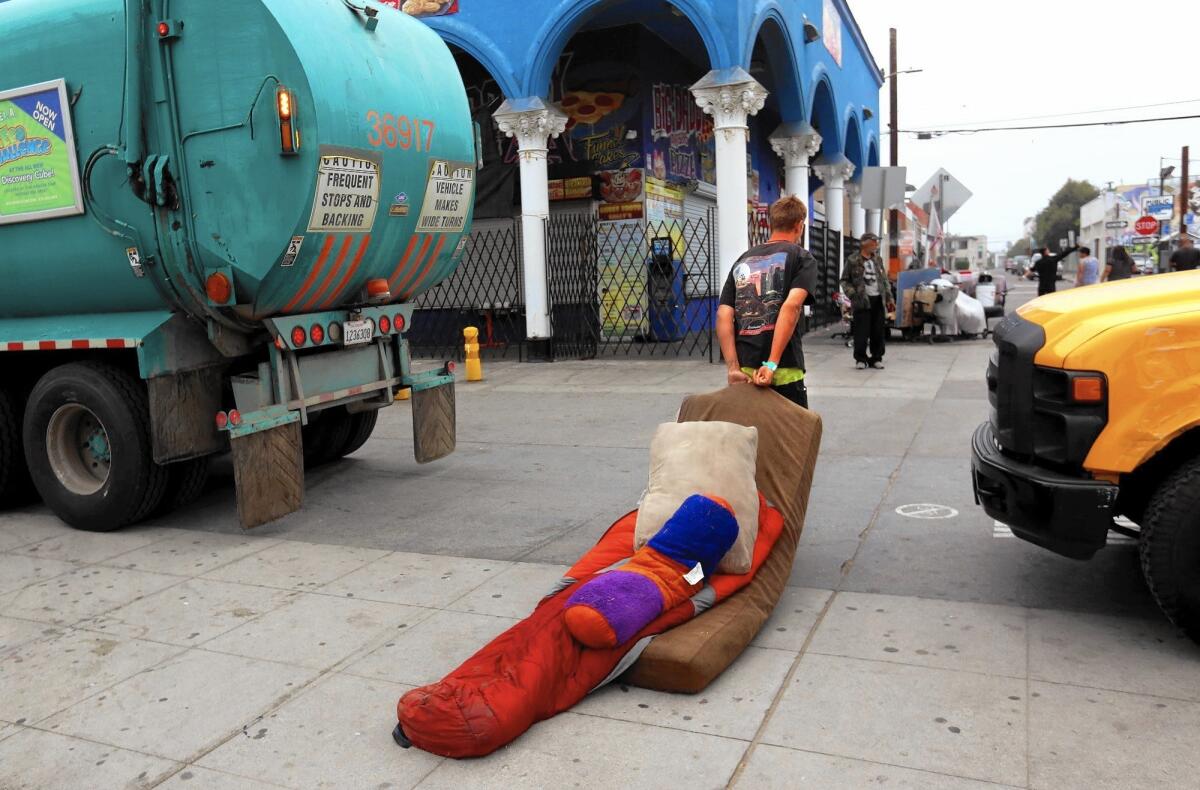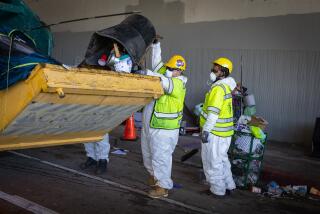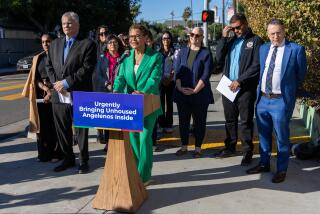Garcetti, City Council throw homeless problem to the police

Mayor Eric Garcetti took office with a promise to end chronic homelessness by the end of 2016.
Instead, two years into his term, we’re throwing $100 million annually at a problem that’s spreading and becoming more entrenched — and Garcetti’s largely been silent on the issue, save for platitudes.
The best solution our City Council has come up with is a return to ham-handed tactics previously tried and discredited: Have the cops seize the belongings of homeless people, then hand out tickets they can’t pay or haul them off to jail.
At the very least, that would get them and their messes out of our sight — and quiet constituent complaints about scruffy transients and homeless encampments cropping up on sidewalks and in neighborhood parks.
Meanwhile our mayor — with his finger in the wind — applauded the council’s plan last week, then suddenly flipped the script. Now he says he won’t sign the measures or let officers carry them out.
The rules can become law without his signature. And he doesn’t have the power to stop police from enforcing them.
It looks to me like our waffling mayor is trying to figure out whether to appease liberal supporters, who think homeless people deserve compassionate treatment, or mollify big business cronies whose bottom lines depend on safe, clean, transient-free streets.
::
We ought to stop saying we’re going to end homelessness by next year — or the next year or the next.
That’s a handy political slogan, but it’s not going to happen.
There are almost 26,000 homeless people living in Los Angeles. And there’s no quick fix that can quiet complaints, clear our sidewalks and ease their suffering.
The “homeless” aren’t a bloc that we can dispatch with tougher rules or more shelter beds. There are as many back stories as there are broken and desperate people.
Ask Maxene Johnston, who spent 10 years in the 1980s and ‘90s running skid row’s Weingart Center, a source for shelter, counseling and job training. Her time in the trenches taught her that most people with nowhere to live fell into one of three groups: the derailed, the disabled or the dysfunctional.
The derailed are ordinary people hobbled by bad luck: You lose a job, get evicted from your apartment, exhaust the goodwill of family and friends. It’s hard to find employment when you stink from living in your car. But with temporary housing and stability, you can be self-sufficient again.
The disabled have mental or physical issues that make it hard to live on their own: You can’t keep track of your medication or keep up with doctor appointments. You’re too handicapped to navigate the maze of social services, or too dependent on the drug dealers who circle skid row like vultures. You need housing that’s secure and offers long-term treatment and attention.
The dysfunctional are chronic street dwellers, with limitations that can’t be addressed with short-term help: You’ve become habituated to outdoor living, comfortable with chaos. Decades of drug addiction have addled your brain and hardened your heart. Or the delusions of severe mental illness keep you isolated and trapped.
That’s the group we’re most afraid of. But even they can be helped for less than we spend on their multiple stints in jails and hospitals.
What we need, Johnston said, is less political grandstanding and more collaboration.
“These poor folks, these drug addicts, these people with mental problems, they’re the public too,” she said. “We have to stop thinking about them as one big terrible nuisance.”
::
We’ve learned a lot in the last 20 years about what it takes to make a dent in homelessness.
The simple answer is homes.
Even people with long-standing addictions, compounded by mental disorders, have a chance at recovery if they have housing while they are receiving treatment, said Gary Blasi, a Public Counsel attorney and retired UCLA professor who’s been studying homelessness for more than 30 years.
“People have virtually no chance of successfully dealing with addiction or mental health problems while they are homeless, even if they receive outpatient services,” Blasi said. And people in supportive housing cost taxpayers less than people on the streets.
That message hasn’t been pitched enough to a public focused more on property values than human dignity.
It’s certainly more politically palatable to enlist police officers to do our dirty work. But not only has that formula failed, it’s made the problem worse.
Police intervention sucks up money that could be used for housing and mental health services. Of the $100 million Los Angeles spent last year combating homelessness, $87 million went to law enforcement — while the number of people on the street continued to increase.
And it’s not just the price tag that makes the approach an obstacle to real solutions.
Handing the problem off to police leads us to think of homeless people as criminals, instead of community members worthy of investment. That makes it hard to win support for spending the public money needed to set things right.
That may be a function of human nature, as much as politics.
“We need to believe that people get what they deserve and deserve what they get,” Blasi said. That ‘just world’ philosophy explains our indifference to the plight of people living on the street.
“There’s an irrational tendency to blame the victim, even when social science tells us otherwise,” he said. “We’re drawn to believe the world is just. Seeing people in our city live like this would wreck our conscience if we didn’t think that they’re to blame for their own problems.”
Twitter: @sandybanksLAT
More to Read
Start your day right
Sign up for Essential California for news, features and recommendations from the L.A. Times and beyond in your inbox six days a week.
You may occasionally receive promotional content from the Los Angeles Times.







